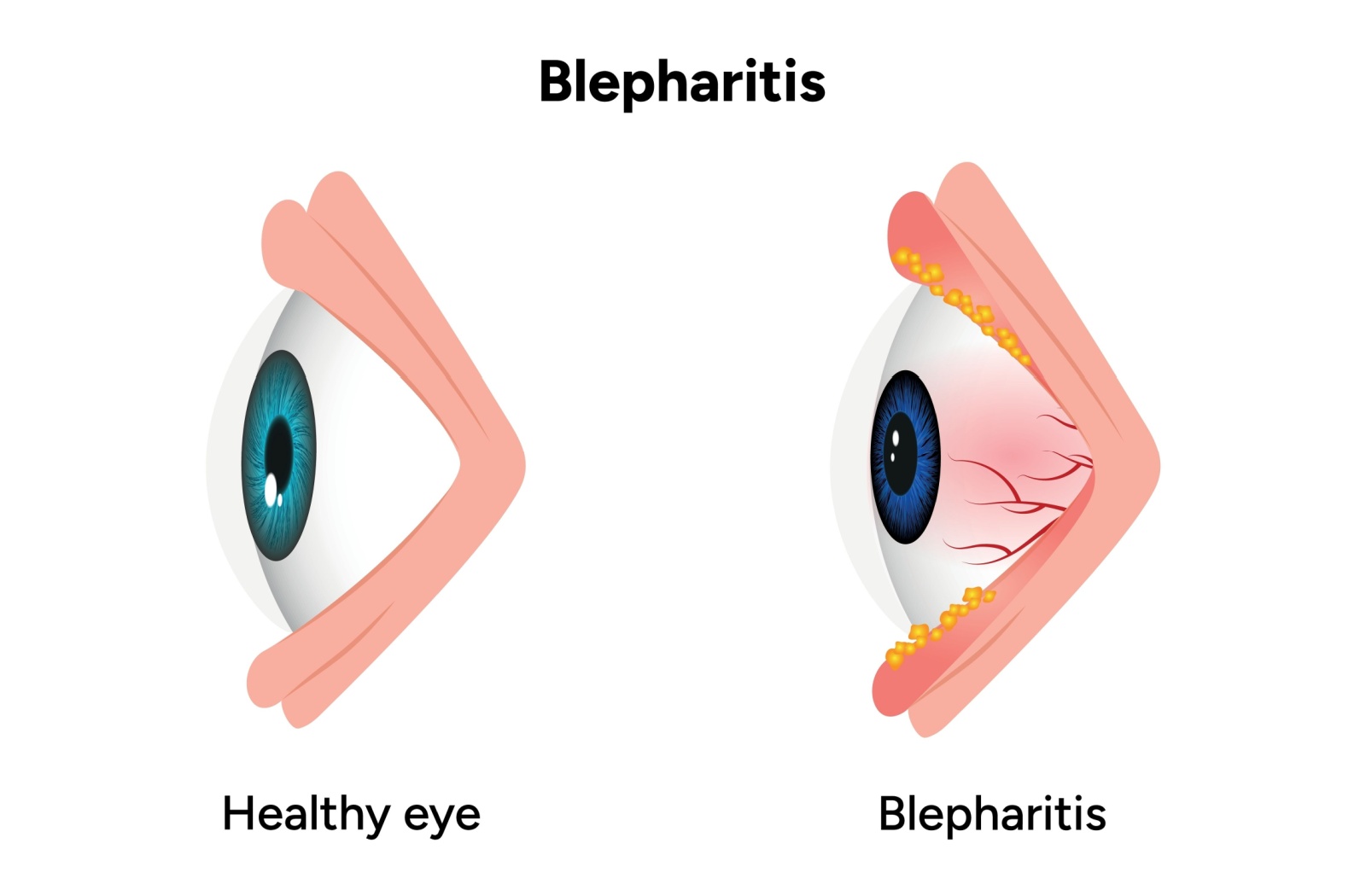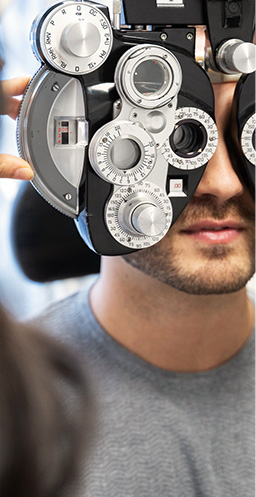Blepharitis is one of the most common eye conditions out there, but it’s also one of the most misunderstood. If you’ve ever dealt with red, irritated eyelids that feel crusty or itchy, you may have wondered where your symptoms came from—and whether they’re contagious.
Blepharitis is not contagious. It develops from internal causes like bacteria, skin conditions, or blocked oil glands and not from person-to-person contact. Though it isn’t a serious or sight-threatening condition, blepharitis can still be stubborn and uncomfortable without consistent care.
What is Blepharitis?
At its core, blepharitis refers to inflammation that affects the eyelid margins, typically where the eyelashes meet the skin. This inflammation often leads to:
- Redness and swelling.
- Irritation or discomfort, particularly in the morning.
- A gritty or burning sensation in the eyes.
Though symptoms can vary widely from one individual to another, blepharitis itself requires consistent care to minimize its effects. Thankfully, by learning how to manage symptoms and underlying triggers, you can maintain healthier eyes and greater comfort.
Types of Blepharitis
Blepharitis falls into two main categories, depending on the part of the eyelid that’s affected:
Anterior Blepharitis
This type of blepharitis affects the outer edge of the eyelid, near the base of your eyelashes. Its common causes include:
- Bacterial infections such as staphylococcal bacteria.
- Dandruff build-up from the scalp or eyebrows.
- Eyelash mites (Demodex) or certain allergic reactions to makeup.
Symptoms often involve noticeable redness, flaking of skin around the base of eyelashes, and discomfort.
Posterior Blepharitis
Posterior blepharitis impacts the inner eyelid and occurs when the meibomian glands, which are responsible for producing the oils needed for tear protection, become clogged. This condition is often linked to:
- Skin conditions, such as rosacea or eczema.
- Chronic scalp dandruff.
- Hormonal changes or imbalances.
While it’s possible to experience only one type of blepharitis, many people suffer from both forms.

What Causes Blepharitis?
Blepharitis doesn’t stem from interaction with others, as it’s entirely non-contagious. Rather, it develops from internal irritants or reactions, whether bacterial or environmental. Some of the common causes include:
- Blocked oil glands in the eyelids.
- Skin conditions, such as rosacea or seborrheic dermatitis.
- Allergic reactions to eye makeup or contact lenses.
- Bacterial infections or an overgrowth of staphylococcal bacteria.
- Mite infestations (Demodex) along the lash line.
- Poor eyelid hygiene, which can exacerbate irritation.
Identifying the specific cause of your blepharitis is important for treatment. We can help evaluate your symptoms and determine the condition’s root cause.
Recognizing Symptoms of Blepharitis
The symptoms of blepharitis vary greatly, but they often overlap with other eye conditions. Common indications of the condition include:
- Eyelid irritation, often resulting in redness, swelling, or itchiness.
- Crusty buildup forming near the base of the eyelashes.
- A gritty sensation, as if something is stuck in your eye.
- Light sensitivity or excessive tearing.
- Burning sensations that worsen at certain times of day, especially mornings.
If you experience any of these symptoms, consult with an eye care professional. Early diagnosis can make managing blepharitis significantly easier and reduce flare-ups.
Treatments for Blepharitis
Effectively managing blepharitis involves both in-office procedures and at-home care. Here are some treatments designed to reduce inflammation, clear blockages, and support long-term eyelid health.
Eyelid Wipes
Daily cleansing with medicated or specially formulated eyelid wipes helps remove debris, bacteria, and oil buildup from the lash line. These wipes are designed for gentle use and are a cornerstone of any effective blepharitis routine, especially for patients with recurring symptoms.
Eyelid Warming Masks
Applying a warm compress helps loosen oil blockages in the meibomian glands. Reusable eyelid warming masks provide consistent heat, encouraging proper oil flow and reducing inflammation. Regular use can ease symptoms like dryness, irritation, and burning.
Blephex Treatment
BlephEx® is an in-office procedure that gently exfoliates the eyelid margins using a precision cleaning device. By removing biofilm, bacteria, and debris, BlephEx helps treat the underlying causes of blepharitis and restores eyelid comfort. It’s a great option for patients experiencing chronic or moderate-to-severe cases.
ZEST Treatment
ZEST (Zocular Eyelid System Treatment) is a gentle, in-office alternative to BlephEx® that achieves similar results in managing blepharitis. Using a patented okra-based gel, it softly exfoliates the eyelid margins to remove bacterial biofilm, debris, and excess oils without causing discomfort. This deep-cleansing approach helps restore healthy meibomian gland function, reduce inflammation, and relieve symptoms such as redness, irritation, and dryness. Patients find the treatment very comfortable, making it ideal for those with sensitive eyes or inflamed lids. Results are often noticeable after a single session and can be maintained with a consistent at-home lid hygiene routine.
Hypochlorous Acid (HOCL)
In blepharitis, bacterial overgrowth (e.g., Staphylococcus aureus) along the lid margins contributes to inflammation, crusting, and meibomian gland dysfunction.
HOCl kills bacteria, reduces bacterial toxins, and helps limit biofilm formation — all without damaging delicate eyelid skin. It also helps reduce inflammatory mediators and oxidative stress at the eyelid margin while helping to relieve redness, swelling, and irritation. There are two ways to use HOCL for blepharitis:
Spray method: Close your eyes, spray HOCl onto the lash line from a few inches away, and let it air dry.
Wipe method: Spray onto a cotton pad or gauze, then gently wipe along the lash margin.
This step removes bacteria, debris, and residual oils.
Daily use of HOCL for lid hygiene helps keep bacterial load under control, reducing flare-ups and recurrence of anterior blepharitis.
Prescription Eye Drops
In some cases, we may prescribe antibiotic, steroid, or anti-inflammatory eye drops to reduce swelling or control bacterial growth. These medications are typically used during flare-ups or in more severe cases of blepharitis to calm inflammation and promote healing.
Finding Comfort & Relief
Living with blepharitis can sometimes feel overwhelming, especially when symptoms flare up. The good news is that consistent care and proper treatment can help you regain control, leading to healthier eyelids and more comfortable eyes.
If you’re experiencing persistent discomfort or are unsure how to manage your blepharitis, don’t hesitate to reach out to us at Stoney Creek Eye Care. Our team is here to provide care, recommend treatments, and offer eyelid hygiene kits suited to your needs.
Contact us today to schedule a comprehensive evaluation and take the first step toward lasting relief.









